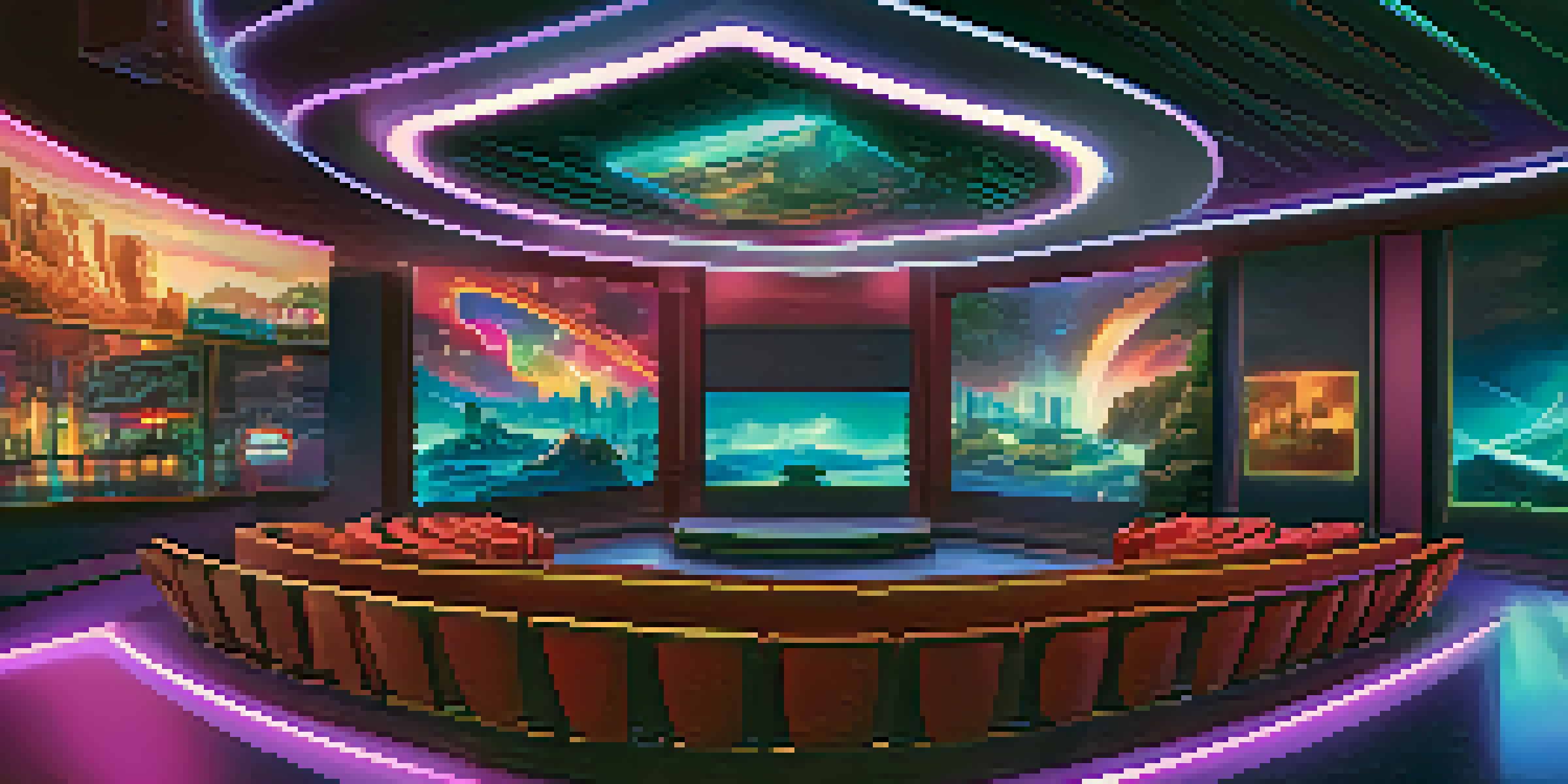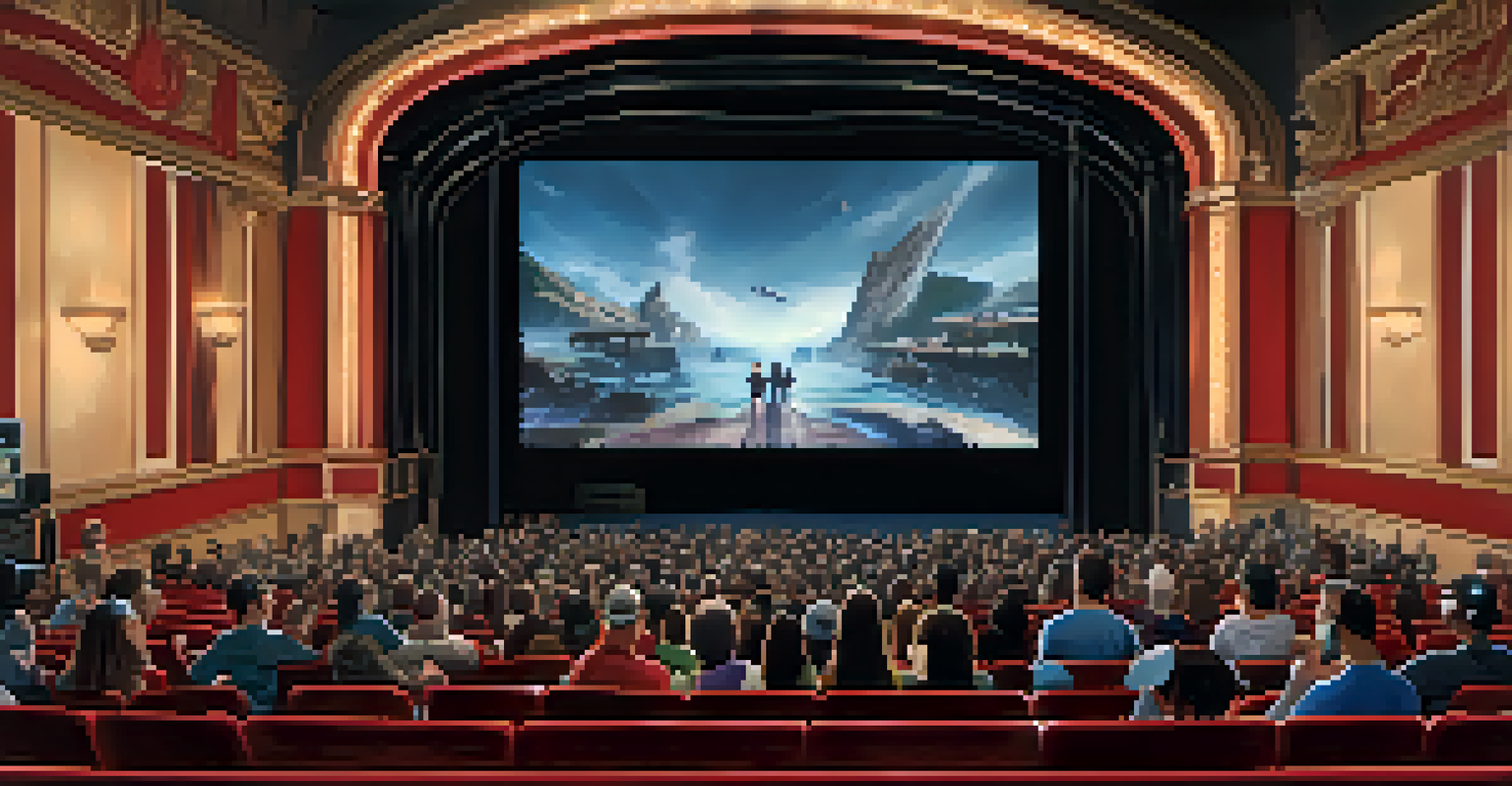The Role of Virtual Reality in Future Film Theaters

Introduction to Virtual Reality in Cinema
Virtual reality (VR) is revolutionizing how we experience films, moving beyond traditional viewing methods. Imagine stepping into a movie instead of just watching it; that's the magic VR brings to the table. As technology advances, the integration of VR into cinema offers filmmakers and audiences new ways to connect with stories.
Virtual reality is not just a new way to experience media; it is a new way to experience life.
The immersive nature of VR allows viewers to engage with the narrative on a deeper level, creating a sense of presence that standard films can't achieve. This technology can transport us into fantastical worlds where we can interact with characters and environments. With VR, the line between audience and participant is increasingly blurred.
As we explore the role of VR in future film theaters, it’s essential to consider both its potential and challenges. While the promise is exciting, ensuring accessibility and affordability for theaters and viewers alike is crucial for widespread adoption. Let’s dive into how VR could reshape our cinematic experiences.
Creating Immersive Experiences with VR
One of the standout features of VR is its ability to create fully immersive experiences. Picture yourself walking through a historical landscape or standing alongside your favorite characters during a pivotal scene. This immersion can make the storytelling even more compelling, allowing audiences to feel emotions in a way that standard films can't replicate.

Filmmakers are now experimenting with narrative structures that leverage this immersive quality. Instead of a linear story, viewers might experience multiple perspectives or outcomes within the same film. This opens up endless possibilities for creativity, encouraging filmmakers to push the boundaries of storytelling.
VR Transforms Film Experiences
Virtual reality revolutionizes cinema by offering immersive and interactive storytelling that engages viewers on a deeper level.
However, creating these experiences requires careful planning and innovative technology. Filmmakers must consider how to engage the audience while ensuring that the VR experience remains cohesive and enjoyable. Balancing immersion with narrative clarity will be key to successful VR films.
The Role of Interactive Storytelling
VR introduces the concept of interactive storytelling, where viewers can make choices that influence the narrative. Imagine being able to decide the fate of a character or how a scene unfolds; this level of engagement can redefine the way we consume films. It transforms passive viewing into an active adventure.
The future of storytelling is interactive, immersive, and deeply personal.
This interactive element can also foster a deeper connection with the material. When viewers feel they have a stake in the story, they are more likely to invest emotionally in the characters and events. This can lead to a more memorable experience that resonates long after the credits roll.
However, integrating interactivity into films poses unique challenges. Filmmakers must strike a balance between allowing audience choice and maintaining a coherent story. The success of this approach will depend on their ability to craft engaging narratives that accommodate multiple pathways.
Enhancing Social Experiences in Theaters
One might think that VR could isolate viewers, but it actually has the potential to enhance social experiences in theaters. Imagine attending a VR film with friends, where you can share the experience and discuss your reactions in real-time. This communal aspect can create a new way to enjoy films together, even in a virtual space.
Some theaters are already experimenting with VR options that allow groups to experience films collaboratively. This trend could lead to new business models for cinemas, blending traditional movie watching with immersive VR experiences. It’s an exciting avenue for theaters to attract audiences looking for a unique night out.
Challenges in VR Implementation
The integration of VR in theaters faces hurdles such as high costs, ensuring comfort, and training staff to assist audiences.
While the technology is still evolving, the social potential of VR in theaters is undeniable. As audiences seek more interactive and shared experiences, theaters that embrace VR could find themselves at the forefront of a new entertainment revolution.
Challenges of Implementing VR in Theaters
Despite its exciting prospects, implementing VR in theaters comes with significant challenges. One major hurdle is the cost of VR equipment and the infrastructure needed to support immersive experiences. For many theaters, especially smaller ones, investing in this technology can be a daunting prospect.
Additionally, ensuring a seamless and comfortable VR experience for audiences is crucial. Issues like motion sickness or discomfort with headsets could deter viewers from embracing this new format. The need for user-friendly technology that enhances rather than detracts from the experience is paramount.
The industry must also address the training required for staff to assist audiences with VR setups. As theaters embrace this shift, ensuring that both employees and viewers are comfortable with the technology will be key to its success.
The Future of Film Genres in VR
As VR technology evolves, we can expect to see new genres emerging specifically designed for this medium. Traditional horror films could become even more terrifying when viewers can look around and interact with the environment. Likewise, romance films can offer intimate experiences that draw the audience into the heart of the story.
Moreover, genres that rely heavily on visual storytelling, such as fantasy and sci-fi, can leverage VR's immersive capabilities to create breathtaking visuals and experiences. The possibilities for creativity are nearly limitless, as filmmakers explore how to engage audiences in new and exciting ways.
Emerging Genres in VR Film
As VR technology evolves, new film genres tailored to its immersive capabilities will challenge filmmakers to innovate and engage audiences.
As audiences become more accustomed to VR experiences, we may see a demand for diverse genres tailored to this format. This evolution will challenge filmmakers to think outside the box and develop narratives that fully utilize the strengths of VR technology.
Conclusion: Embracing the Future of Cinema
In conclusion, the integration of virtual reality into film theaters represents a thrilling shift in how we experience storytelling. As the technology matures, it holds the potential to revolutionize not only the film industry but also how we relate to narratives and characters. The immersive and interactive nature of VR can deepen our emotional connections to stories.
While obstacles remain, the excitement around VR in theaters is palpable. Filmmakers, theater owners, and audiences alike must work together to navigate these challenges and embrace the opportunities that VR presents. The future of cinema is bright and promising, filled with innovative experiences waiting to be explored.

So, are you ready to step into the next generation of film? With virtual reality on the horizon, the world of cinema is about to become more immersive and engaging than ever before. Let’s keep an eye on the developments in this space and be prepared for an exhilarating ride.